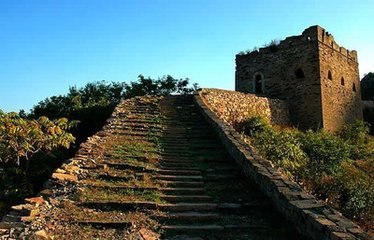The Great Wall of China, a world heritage site, has suffered severe damage from both natural and man-made corrosion over the years.
世界文化遗产之一,中国的万里长城,多年来,在自然环境的侵蚀和人为破坏下,饱经沧桑,生存状况堪忧。
As the world's biggest defense project, it was first started more than 2,000 years ago, and what is left today was mostly built during the Ming Dynasty (1368-1644).
作为世界上最大的防御工程,长城最早于2000多年前开始修建,今天我们所看到的长城大多是修建于明朝时期(1368-1644年)。
However, not all of the Wall is preserved like the Badaling section in northern Beijing. According to a 2012 report by the State Administration of Cultural Heritage, of the 6,259 kilometers of the Ming Dynasty Wall, less than 10 percent is well preserved, while 31 percent of the Wall, or 1,961 kilometers, has disappeared. The remaining several thousand kilometers of the Wall has been dilapidated because of wind and rain, as well as human activities.
然而,并非所有的长城都像北京北部的八达岭长城那样保存完好。据国家文物局2012年统计数据显示,全长6259公里的明代长城,保存完好的部分仅有不到10%,而31%的城墙(约1961公里)已消失在了历史长河中。由于风雨侵蚀和人类活动,剩下的几千公里城墙也都破旧不堪。

In Shanxi Province, which is home to more than 3,500 kilometers of the Wall built in different historical periods, stealing of bricks from the Wall has been rampant, especially during the socially turbulent years.
山西省内的长城长达3500多公里,建于不同的历史时期。当地人从城墙上偷砖块的行为一直很猖獗,特别是在社会动荡的岁月。
Ge Shufang from Deshengbao village near the Wall, who is now a member of the Datong People's Congress, has been promoting awareness among local villagers for more than a decade. Now that more tourists are coming to the village to see the Wall, the villagers have realized its value, and are starting to benefit from the tourism business.
大同市人大代表葛书芳来自长城脚下的大胜堡村,十多年来一直致力于提高当地居民保护长城的意识。现在,随着越来越多的游客来到村子里参观长城,村民们终于意识到它的价值,并开始从旅游业中受益。
However, pursuit of economic return has also ruined the Wall in some places. In order to cash in from tourism, the Youyu county in Shanxi leveled off the Wall in Shahukou and rebuilt the section with a tacky new design, drawing fierce criticism from conservation experts.
然而,对经济回报的追求也破坏了一些地方的城墙。为了从旅游中获利,山西右玉县杀虎口的长城被推平,翻新重修,它失去了古风的新设计遭到了文物保护专家的强烈批判。













